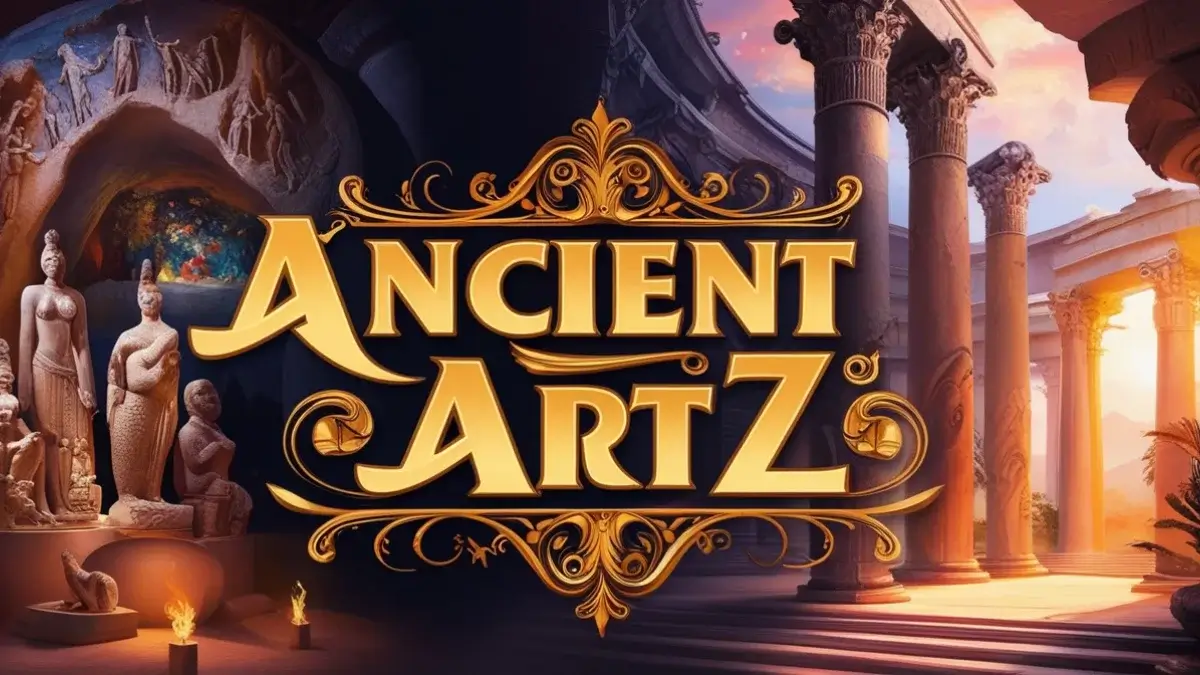Ancient Artz: Unveiling History’s Secrets Through Timeless Art
Ancient artz is a window into humanity’s earliest civilizations, capturing the emotions, beliefs, and values of people from thousands of years ago. By studying ancient art, we glimpse the daily lives, spiritual worlds, and cultural values of societies long past, from the sophisticated civilization of Mesopotamia to the sacred artistry of ancient Egypt. Ancient artz is not just an array of artifacts; it’s a testament to the human desire to create, communicate, and memorialize experiences, demonstrating that art was as significant to our ancestors as it is to us today.
Art of this era wasn’t merely decorative—it held profound symbolic meaning, often linked to religious beliefs and societal hierarchy. Through intricate sculptures, vivid cave paintings, and awe-inspiring architectural marvels, ancient societies encoded their knowledge and experiences, creating a legacy that has outlasted millennia. The influence of these ancient forms of expression reverberates through history, impacting artistic movements and cultural trends that persist in the modern world.
Defining the Scope of Ancient Artz
Ancient artz encompasses a vast spectrum of creative expressions, from prehistoric times to the early Middle Ages, spanning various regions and cultural landscapes. Its scope includes painting, sculpture, architecture, and portable artifacts, each offering a unique glimpse into the technological and creative capabilities of ancient civilizations. By exploring art across diverse locations and cultures, including the Nazca Lines in Peru and the Bhimbetka Rock Shelters in India, we gain a panoramic view of human ingenuity across time and place.
Each civilization adapted art to serve its unique cultural and religious needs, yielding a rich variety of styles, materials, and techniques. Whether it’s the architectural grandeur of the Colosseum in Rome or the spiritual symbolism of Egyptian hieroglyphs, ancient art reflects the distinct perspectives and values of its creators, making it essential to understanding global history.
Types and Techniques in Ancient Art
Ancient artz can be categorized into three primary forms: sculpture, painting, and architecture. Each type served different purposes, from honoring gods to documenting daily life, and used distinct techniques and materials. For example, sculptures ranged from small, portable figurines like the Venus of Willendorf to monumental statues like the Moai of Easter Island, carved meticulously to honor ancestors or deities.
In painting, ancient artists used natural pigments to create scenes on cave walls, pottery, and frescoes, each artwork telling a story or conveying a cultural message. Architecture in ancient times was equally impressive, as civilizations created enduring structures like Egypt’s Temple of Karnak and Mesopotamia’s Ishtar Gate. These techniques, honed over centuries, showcase the evolution of human artistic skill and creativity.
Symbolism and Cultural Significance
Symbolism was integral to ancient art, conveying beliefs, values, and even political messages that resonated deeply within ancient societies. Many artworks included religious or mythological elements that spoke to the civilization’s understanding of the universe. Egyptian art, for example, often featured symbols like the Ankh, representing life, or depictions of gods and pharaohs, illustrating the connection between the earthly and the divine.
Symbols were not limited to Egyptian art; they were also prevalent in other regions. The spiral patterns on the walls of Neolithic monuments or the Olmec Heads of Mexico conveyed cultural identity and power. Through these symbolic artworks, ancient civilizations could communicate complex ideas, asserting cultural narratives that have endured across the centuries.
Prominent Discoveries and Historical Artifacts
Several monumental discoveries of ancient art have illuminated the grandeur and diversity of these early creations. The Chauvet Cave in France, featuring prehistoric cave paintings of animals dating back over 30,000 years, provides one of the earliest records of human creativity. Similarly, the Mohenjo-Daro ruins in the Indus Valley reveal an advanced civilization with intricate art forms and urban planning techniques.
Other artifacts, like the colossal stone Olmec Heads of Mexico and the elaborate Persian Miniature Paintings, demonstrate the intricate craftsmanship and artistic precision of ancient artists. These discoveries serve as both historical records and sources of inspiration, giving modern observers a tangible connection to humanity’s creative roots.
Impact and Legacy of Ancient Artz on Modern Art
The influence of ancient artz extends beyond its time, shaping the foundations of contemporary art and culture. Many modern artists draw inspiration from ancient themes, techniques, and symbols, incorporating them into contemporary forms and media. For instance, the timeless beauty of Greek sculptures and the architectural mastery of the Colosseum have influenced modern art, inspiring artists to pursue beauty and structural perfection in new ways.
Moreover, ancient art continues to impact architecture, with many modern buildings reflecting classical styles and borrowing elements from monumental structures like Stonehenge and the Egyptian pyramids. This enduring legacy showcases ancient art’s relevance, highlighting its role in inspiring creativity and innovation throughout human history.
What is Ancient Artz?
Ancient artz can be defined as the creative expressions of early human civilizations, capturing their ideologies, lifestyles, and beliefs in a way that transcends time. From intricate cave paintings in Chauvet Cave, France, to the monumental statues of ancient Egypt, ancient artz encompasses all art forms predating the fall of the Roman Empire. These artworks provide insight into the past, offering a cultural and historical narrative preserved in stone, paint, and clay.
The term “ancient artz” spans not only a wide geographic area but also a diverse array of materials and techniques. Whether in the form of Mesopotamian cylinder seals or the elaborate Persian Miniature Paintings, ancient artz reflects the skills and priorities of early societies. By examining this art, we understand the values, beliefs, and aspirations that shaped ancient cultures, offering a timeless connection to our shared human heritage.
Timeline: How Old is Ancient Artz?
Ancient artz stretches back tens of thousands of years, from the earliest cave paintings dating to approximately 40,000 BCE, to the sophisticated art of ancient empires like Egypt and Greece, which flourished around 3,000 BCE. Prehistoric art, such as the Lascaux Cave paintings in France, marks the dawn of human creativity, revealing early attempts to interpret the natural world through art.
As civilizations developed, art forms grew increasingly sophisticated. Mesopotamian, Egyptian, and Indus Valley art emerged around 3000 BCE, each introducing unique styles and innovations. Classical Greek and Roman art later transformed the landscape of sculpture and architecture, culminating in a legacy of creative excellence that has profoundly influenced subsequent art forms worldwide.
The Three Primary Types of Ancient Artz
Ancient artz can be divided into three main categories: sculpture, painting, and architecture. Sculptures from this era, such as the Nefertiti Bust in Egypt and the Terracotta Army in China, showcase remarkable craftsmanship and were often created to honor gods or commemorate important figures. These works remain some of the most recognized artifacts from ancient times, embodying the artistic skills and cultural values of their creators.
Painting, another significant art form, included vibrant murals, pottery decorations, and frescoes that conveyed religious themes and mythological stories. Architecture, exemplified by awe-inspiring structures like the Parthenon in Greece and the Ishtar Gate in Babylon, represents the artistic and engineering prowess of ancient societies. Each of these categories demonstrates humanity’s enduring drive to create, express, and preserve its identity.
Also Read: Luuxly.com: Elevating Your Luxury Lifestyle in the Digital Era
Key Elements of Ancient Artz
Ancient artz is characterized by several key elements, including form, line, color, texture, space, symbolism, and composition. Form and line define the shape and structure of an artwork, as seen in the precise lines of Egyptian hieroglyphs or the bold forms of Greek statues. Color, though often faded over time, played an essential role, symbolizing aspects of culture and religion, such as the use of red to signify power.
Symbolism is also prominent in ancient art, with icons representing various gods, beliefs, and cultural practices. For instance, the spirals and animal motifs found in prehistoric art often held spiritual significance. These elements, combined with thoughtful composition, gave ancient artworks their unique aesthetic appeal, turning them into powerful representations of ancient cultures.
Famous Ancient Art Discoveries Worldwide
Some of the most famous discoveries in ancient art offer an unparalleled look at early human creativity. The Venus of Willendorf, a small carved figure dating back around 25,000 years, reflects early artistic representations of the human form. The Nazca Lines in Peru, with their massive geoglyphs depicting animals and shapes, remain a marvel of ancient engineering and artistic skill.
In addition, Stonehenge in England and the Moai statues of Easter Island stand as iconic testaments to ancient architectural ingenuity and cultural identity. These discoveries, spanning different continents and time periods, showcase the universal drive to create and the shared artistic impulses that have united humanity throughout history.
Conclusion: The Legacy of Ancient Artz
The legacy of ancient artz continues to influence modern society, offering insights into the values, beliefs, and creative aspirations of our ancestors. By studying ancient art, we not only preserve historical knowledge but also gain a deeper appreciation for the ingenuity and resilience of early cultures. Each artifact serves as a reminder of our shared human heritage and our ongoing quest to understand existence.
Ancient artz connects the past and present, bridging generations through shared expressions of creativity. As we explore and preserve these artifacts, we honor the rich diversity of human culture, recognizing that art has always been and will continue to be a vital means of communication, self-expression, and connection.
Frequently Asked Questions (FAQs)
What is the significance of ancient artz?
Ancient artz provides valuable insight into the cultural, religious, and societal aspects of early civilizations. It serves as a visual record of human development, beliefs, and creativity across millennia.
Which civilizations contributed most to ancient artz?
Several ancient civilizations contributed to ancient artz, including Mesopotamia, Egypt, Greece, Rome, the Indus Valley, and the Olmecs, each creating unique artistic legacies.
What are the primary types of ancient art?
The main types of ancient art include sculpture, painting, and architecture. These forms were used to depict gods, convey beliefs, and honor rulers, leaving behind timeless masterpieces that inspire awe to this day.
What materials did ancient artists use?
Ancient artists used natural materials such as stone, clay, pigments from minerals, and metals like bronze to create sculptures, paintings, and tools.
How does ancient artz influence modern art?
Ancient artz continues to inspire modern artists, architects, and designers, who often draw from its themes, forms, and symbolism to create contemporary works.
What are some famous examples of ancient artz structures?
Famous structures include the Colosseum in Rome, the Pyramids of Giza in Egypt, and Stonehenge in England, all showcasing advanced engineering and artistry.
What role did religion play in ancient artz?
Religion was central to ancient artz, with many artworks depicting gods, mythological stories, and rituals that reflect the spiritual beliefs of early societies.
How are ancient artworks preserved?
Conservation methods like climate control, digital scanning, and protective barriers help preserve ancient artworks from environmental and human damage.


